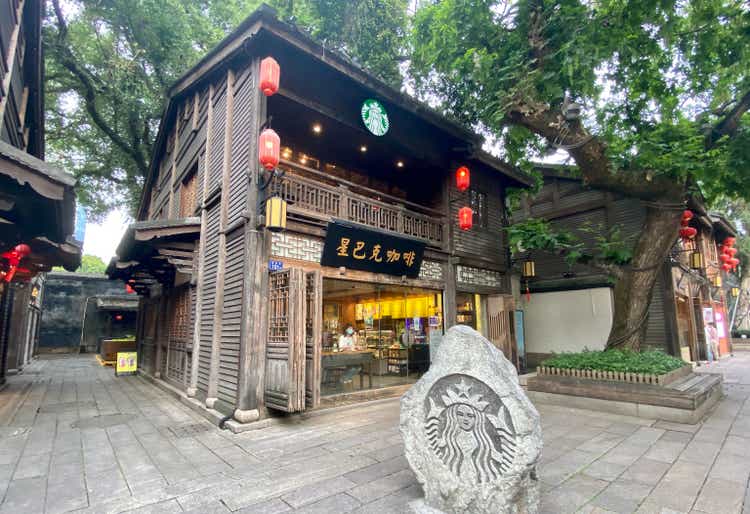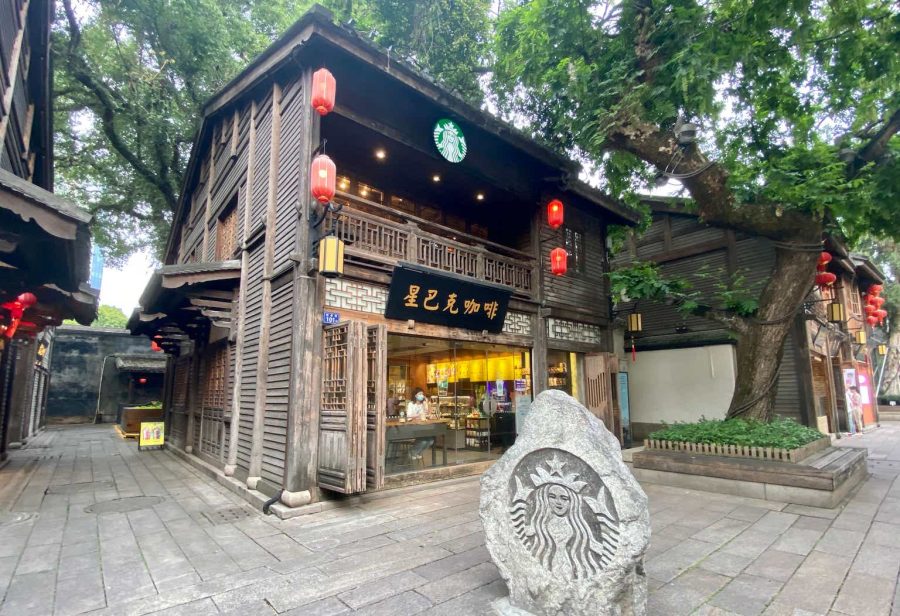Summary:
- SBUX recorded a 25% decline in EPS from the prior year, led by pronounced traffic decline in the US and intensifying competition in China.
- The performance in Asia ex-China was still intact.
- In response to the intensifying competition in China, Starbucks rapidly expanded its stores and joined the mass segment price war.
- A quick turnaround within the next 12 months is unlikely.
xiaoke chen/iStock Unreleased via Getty Images
Starbucks (NASDAQ:SBUX) announced its third quarter financial results with optimism, but rescinding it due to poor performance in North America and China in the fourth financial quarter, based on its preliminary results.
SBUX posted total revenue of $9.1 billion, down 3% year-over-over and flat over FQ3. The disappointing results were primarily driven by a 6% decline in comparable store sales in the US, and a 14% drop in China comparable store sales.
The Seattle-based company had demonstrated its resilience in combating the current challenging macroeconomic backdrop.
Here are some notable highlights:
- Extending mobile order and pay function to non-Starbucks Reserve members
- Introducing Siren Craft System
- Identifying outlier stores and prioritising deployment of Siren Craft System in those stores
- Retrofitting espresso machines
- Accelerating the pace of new store builds and renovations
The above intends to remove barriers for non-Starbucks Reserve members, reduce waiting time, and improve customer experiences. The company expected an opportunity to improve comps by 1% to 1.5%.
However, the company still witnessed pronounced traffic decline. A cautious consumer environment and challenging economic backdrop were undermining their efforts. Overall earnings per share for this financial quarter plummeted 25% from the prior year to $0.80.
Strengths in Asia ex-China
In the other part of the world, the performance in Asia ex-China was still intact. In Japan and South Korea, there are around 200 new stores opened in the last two years, representing a 12% and 13% increase. We also see similar growth rates in Cambodia, India, Indonesia, Malaysia, the Philippines, Thailand and Vietnam.
Out of the above Asian countries, only Starbucks in Japan is company-operated. The company saw double digit growth rate in Japan led by terrific innovation, great execution, strengthened digital presence and the presence of a prominent coffee branding.
The strength in Asian countries partially offset the declined licensed store revenue in other parts of the world.
Price War in China
In this financial quarter, comparable store sales in China plummeted by 14%, accelerating from an 11% decline in Q2 of FY2024 and staying flat in Q3 of FY2024.
The culprit of it is the price war between beverage shops.
According to Investopedia, a price war is a competitive exchange among rival companies who lower the price points on their products, in a strategic attempt to undercut one another and capture greater market share.
The beverage shop landscape in China is competitive and scattered.
Starbucks was first introduced to China 25 years ago, and the brand has opened over 7,300 stores by June 2024. But its scale was not as gigantic as you may think.
One of its major competitors, Luckin Coffee (OTCPK:LKNCY), owns over 20,000 stores in China. Another major competitor of Starbucks, Cotti Coffee, who initiated the price war, also owns over 7,000 stores in China. It’s worth noting that Cotti Coffee was established in August 2022, which showcases its incredible expansion speed.
Apart from these two close competitors, beverage shops like Heytea, Mixue, Nayuki, Chapanda, Chagee, etc., are also substitutes of Starbucks. They also own thousands of stores across China.
In order to gain market share in a scattered industry, most brands slashed the price to below 10 RMB (equivalent to 1.4 USD). The cheapest you can get is a 6 RMB (equivalent to 0.84 USD) bubble milk tea from Mixue.
This put Starbucks at a huge disadvantage when a normal Starbucks coffee costs around 30 RMB (equivalent to about 4.2 USD).
So, how Starbucks dealt with the fierce competition?
Starbucks is in a dilemma. The market leader can either join the price war to maintain market share but face margin compression, or stay out to maintain profitability, but lose market share to its competitors.
In response to the intensifying competition, Starbucks decided to rapidly expand its store count and joined the mass segment price war.
Starbucks opened over 800 stores in China from Q3 FY2023 to Q3 FY2024, focusing on county cities in particular.
They also utilize promotional activities to attract more customers, such as providing 30% off coupons or buy one get one activity.
Starbucks used to attract Chinese customers by providing high quality coffee with wonderful customer experiences. Unfortunately, this isn’t valid anymore. It was not Starbucks bringing poor quality products and experiences to its customers, but a more cautious consumer atmosphere that halted consumers from purchasing relatively luxurious beverages.
According to the Chinese government, in the first quarter of 2024, the median disposable income for urban citizens was 12,870 RMB (equivalent to about 1,870 USD). Their average consumption expenditure was 8,943 RMB (equivalent to about 1,256 USD), of which 32.2% was for food and beverages.
Hence, it is not surprising that customers voted for price over quality, especially when China is experiencing softness in its economy.
A research done by Heil and Helsen shows that a price war ends when advertising expenditures may be used to signal commitment to the market, thereby increasing others’ willingness to raise prices again and terminate the war.
And we are not seeing signs of that.
Therefore, Starbucks’ struggle in China is likely to persist.
Valuation of Starbucks
Taking into account the preliminary results of the fourth financial quarter, EPS for FY2024 is $3.31, down 8% from prior year.
The company did not provide any guidance for FY2025 due to transition of CEO and challenges encountered in both the US and China.
Excluding the outliner data in FY2020, Starbucks’ 5-year average PE ratio is 29.18, slightly lower than the current PE ratio at 29.40.
Here are my the optimistic and pessimistic cases for Starbucks in FY2025.
I believe challenges in major market will extend into 2025. Optimistically, I foresee EPS in FY2025 to stay flat; while pessimistically, I expect EPS in FY2025 to further decline by 15%.
Due to miserable market sentiment in a declining market cycle, I expect the Street will give Starbucks a lower-than-average multiple over the next twelve months.
| Optimistic Case |
$3.31*29.18 =$96.59 |
| Pessimistic Case |
$3.31*(1-0.15)*25 =$70.34 |
Is Starbucks a Buy?
Even with the company endeavored to fight the challenging business environment, a quick turnaround within the next 12 months is unlikely.
With an unattractive valuation now, I see mostly downside from the Seattle-based company.
Therefore, Starbucks is rated as a “Sell”.
Editor’s Note: This article discusses one or more securities that do not trade on a major U.S. exchange. Please be aware of the risks associated with these stocks.
Analyst’s Disclosure: I/we have no stock, option or similar derivative position in any of the companies mentioned, and no plans to initiate any such positions within the next 72 hours. I wrote this article myself, and it expresses my own opinions. I am not receiving compensation for it (other than from Seeking Alpha). I have no business relationship with any company whose stock is mentioned in this article.
We expect the stock to underperform the broader market in the next 12 months due to the reasons stipulated in the article. Readers should consider the risks of owning it.
Value Voyager is not a professional investment advisor. No information in this publication is intended as investment advice to buy or sell any stock, bonds, derivatives, and any other financial instruments. Value Voyager may utilise past market performance to deduce future performance, but it is not guaranteed that the actual result will meet expectation. Readers should conduct their own research and due diligence before making any investment decision.
Seeking Alpha’s Disclosure: Past performance is no guarantee of future results. No recommendation or advice is being given as to whether any investment is suitable for a particular investor. Any views or opinions expressed above may not reflect those of Seeking Alpha as a whole. Seeking Alpha is not a licensed securities dealer, broker or US investment adviser or investment bank. Our analysts are third party authors that include both professional investors and individual investors who may not be licensed or certified by any institute or regulatory body.
